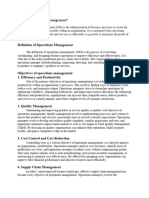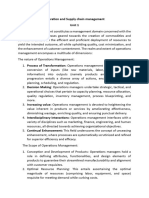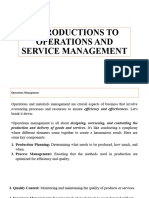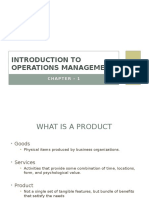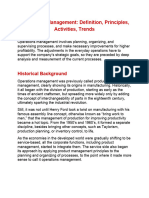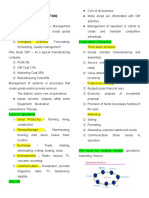0 ratings0% found this document useful (0 votes)
3 viewsNotes
For study purpose
Uploaded by
Azka SheikhCopyright
© © All Rights Reserved
Available Formats
Download as PDF, TXT or read online on Scribd
0 ratings0% found this document useful (0 votes)
3 viewsNotes
For study purpose
Uploaded by
Azka SheikhCopyright
© © All Rights Reserved
Available Formats
Download as PDF, TXT or read online on Scribd
You are on page 1/ 18
Certainly!
Here's an introduction to Operations Management covering
the topics you mentioned:
**Definition and Scope of Operations Management:**
Operations Management (OM) is the field of management concerned
with designing, overseeing, and controlling the process of production
and redesigning business operations in the production of goods or
services. It involves managing resources, processes, and outputs to meet
customer requirements efficiently and effectively. The scope of
operations management includes:
1. **Product Design:** Involves conceptualizing and developing
products or services that meet customer needs and preferences.
2. **Process Design:** Encompasses the creation and optimization of
production processes to ensure smooth and efficient operations.
3. **Capacity Planning:** Involves determining the optimal level of
resources (e.g., labor, equipment, facilities) required to meet demand
while minimizing costs.
4. **Quality Management:** Focuses on ensuring that products or
services meet or exceed customer expectations by implementing quality
control measures.
5. **Inventory Management:** Involves managing inventory levels to
balance the costs of holding inventory with the costs of stockouts.
6. **Supply Chain Management:** Encompasses the coordination of
activities involved in sourcing, procurement, production, and
distribution to deliver products or services to customers.
**Importance of Operations Management in Organizations:**
Operations management plays a crucial role in organizations for several
reasons:
1. **Cost Efficiency:** Efficient operations management can lead to
cost reductions through improved productivity, streamlined processes,
and optimized resource utilization.
2. **Quality Improvement:** Effective operations management helps
maintain and enhance product or service quality, leading to increased
customer satisfaction and loyalty.
3. **Competitive Advantage:** Well-managed operations can provide
a competitive advantage by enabling organizations to deliver products or
services faster, cheaper, and with higher quality than competitors.
4. **Flexibility and Adaptability:** Operations management practices
such as agile manufacturing and flexible production systems allow
organizations to respond quickly to changes in customer demand and
market conditions.
5. **Innovation:** Operations management involves continuous
improvement and innovation in processes, products, and technologies,
driving organizational growth and competitiveness.
**Historical Background and Evolution of Operations
Management:**
The roots of operations management can be traced back to the Industrial
Revolution when manufacturing processes became more mechanized
and standardized. However, the formal discipline of operations
management emerged in the early 20th century with the development of
scientific management principles by Frederick Taylor and the
introduction of assembly line production by Henry Ford.
In the mid-20th century, scholars such as W. Edwards Deming and
Joseph Juran pioneered quality management principles, emphasizing the
importance of statistical analysis and continuous improvement in
production processes.
The late 20th and early 21st centuries witnessed significant
advancements in operations management, driven by technological
innovations such as computer-aided design (CAD), computer-aided
manufacturing (CAM), and enterprise resource planning (ERP) systems.
Concepts like lean manufacturing, total quality management (TQM), and
just-in-time (JIT) production gained prominence, leading to
improvements in efficiency, quality, and customer responsiveness.
Today, operations management continues to evolve with the emergence
of trends such as Industry 4.0, which integrates digital technologies like
Internet of Things (IoT), artificial intelligence (AI), and big data
analytics to create smart, interconnected manufacturing systems capable
of real-time optimization and decision-making.
These historical developments highlight the ongoing evolution and
importance of operations management in driving organizational success
and competitiveness in a rapidly changing global economy.
Certainly! Here's an overview of the functions of Operations
Management, focusing on planning and decision-making, organizing and
designing operations systems, and controlling and improving operations
performance:
**1. Planning and Decision-Making:**
- **Forecasting:** Operations managers utilize various forecasting
techniques to predict future demand for products or services, allowing
them to plan production schedules, inventory levels, and resource
allocation accordingly.
- **Capacity Planning:** This involves determining the optimal level of
resources (e.g., equipment, labor, facilities) needed to meet current and
future demand while balancing costs and capacity constraints.
- **Production Planning and Scheduling:** Operations managers
develop plans and schedules for production activities, considering
factors such as lead times, resource availability, and customer demand to
ensure timely delivery of goods or services.
- **Inventory Planning:** Operations managers must decide how much
inventory to hold at different stages of the production process to
minimize costs while ensuring adequate stock levels to meet demand.
- **Strategic Decision-Making:** Operations managers play a key role
in strategic decision-making, such as selecting manufacturing
technologies, sourcing strategies, and process improvement initiatives to
achieve long-term organizational objectives.
**2. Organizing and Designing Operations Systems:**
- **Facility Layout and Design:** Operations managers design the
layout of production facilities to optimize workflow, minimize
bottlenecks, and maximize efficiency. This includes determining the
placement of equipment, workstations, and storage areas.
- **Process Design:** Operations managers design and redesign
production processes to improve efficiency, quality, and flexibility. This
may involve implementing lean manufacturing principles, reengineering
workflows, or adopting new technologies.
- **Supply Chain Management:** Operations managers organize and
manage the flow of materials, information, and resources from suppliers
to customers, optimizing supply chain processes to reduce lead times,
lower costs, and improve responsiveness.
- **Workforce Planning:** Operations managers are responsible for
organizing and managing the workforce, including recruiting, training,
and scheduling employees to ensure that the right skills are available to
meet production requirements.
**3. Controlling and Improving Operations Performance:**
- **Quality Control:** Operations managers implement quality control
measures to monitor and ensure that products or services meet
established standards and specifications. This may involve statistical
process control, inspection, and corrective action procedures.
- **Performance Measurement:** Operations managers track key
performance indicators (KPIs) such as productivity, efficiency, quality,
and customer satisfaction to evaluate operations performance and
identify areas for improvement.
- **Continuous Improvement:** Operations managers facilitate
continuous improvement initiatives such as total quality management
(TQM), Six Sigma, and lean manufacturing to identify and eliminate
waste, reduce variability, and enhance overall operational efficiency.
- **Supply Chain Optimization:** Operations managers continuously
monitor and optimize supply chain processes to minimize costs, reduce
lead times, and improve reliability through initiatives such as vendor
management, inventory optimization, and demand forecasting.
By effectively planning, organizing, controlling, and improving
operations, operations managers can enhance organizational
performance, achieve strategic objectives, and gain a competitive
advantage in the marketplace.
III. Operations Strategy:
Defining Operations Strategy:
Definition: Operations strategy refers to the plans and decisions
made by an organization regarding its operations function to
support the overall business strategy. It involves setting objectives,
making resource allocation decisions, and designing processes to
achieve competitive advantage through efficient and effective
operations.
Components: Operations strategy encompasses decisions related
to capacity planning, process design, technology adoption, quality
management, supply chain management, and workforce
management, among others.
Aligning Operations Strategy with Business Strategy:
Strategic Fit: Operations strategy should be aligned with the broader
business strategy to ensure consistency and support organizational goals.
This alignment involves understanding the market positioning,
competitive priorities, and value proposition of the business.
Competitive Priorities: Operations strategy must reflect the competitive
priorities of the business, whether it's focused on cost leadership,
differentiation, speed, flexibility, or quality.
Resource Allocation: Operations strategy determines how resources such
as labor, capital, and technology are allocated to support business
objectives while balancing trade-offs between competing priorities.
Operations Strategy in Different Industries and Contexts:
Manufacturing Industry: In manufacturing, operations strategy
often focuses on improving efficiency, reducing lead times, and
ensuring product quality through techniques such as lean
manufacturing, Six Sigma, and total quality management (TQM).
Service Industry: In the service sector, operations strategy
emphasizes factors such as service delivery speed, customization,
and customer experience. Service operations may involve
strategies for capacity management, demand forecasting, and
service innovation.
Global Context: Operations strategy in a global context involves
considerations such as outsourcing, offshoring, and international
supply chain management to leverage global resources, access new
markets, and manage geopolitical risks.
IV. Process Management:
Defining and Analyzing Business Processes:
Definition: A business process is a series of interrelated tasks or
activities performed to achieve a specific objective, such as fulfilling a
customer order or processing a transaction. Process management
involves identifying, analyzing, and optimizing these processes to
improve efficiency and effectiveness.
Process Analysis: Process analysis techniques such as value stream
mapping, time-motion studies, and process flow analysis are used to
understand the flow of activities, identify bottlenecks, and measure
performance metrics.
Process Documentation: Documenting business processes using tools
like flowcharts, process maps, and procedure manuals helps
communicate process requirements, standardize procedures, and
facilitate continuous improvement.
Certainly! Here are some relevant notes on Process Management and
Supply Chain Management:
**Process Management:**
1. **Defining and analyzing business processes:**
- Understanding the sequence of activities involved in delivering a
product or service.
- Identifying inputs, outputs, and key stakeholders involved in each
process.
- Analyzing the efficiency and effectiveness of current processes
through metrics like cycle time, throughput, and error rates.
2. **Process mapping and design:**
- Utilizing tools like flowcharts, swimlane diagrams, or value stream
maps to visually represent processes.
- Identifying bottlenecks, redundancies, and opportunities for
optimization.
- Designing new processes or refining existing ones to improve
outcomes, reduce costs, or enhance customer satisfaction.
3. **Process improvement and re-engineering:**
- Implementing methodologies like Lean Six Sigma or Kaizen to
systematically improve processes.
- Conducting root cause analysis to identify underlying issues.
- Redesigning processes from scratch (re-engineering) to achieve
significant improvements in performance, quality, or efficiency.
**Supply Chain Management:**
1. **Defining supply chain management:**
- Coordination of activities involved in sourcing, procurement,
production, and distribution to meet customer demand.
- Involves suppliers, manufacturers, distributors, retailers, and
customers in a networked system.
2. **Supply chain strategy and design:**
- Developing strategies to optimize the flow of materials, information,
and finances across the supply chain.
- Designing supply chain networks considering factors like cost, speed,
flexibility, and responsiveness to changes in demand.
3. **Managing supply chain risk and performance:**
- Identifying and assessing risks such as supplier disruptions, demand
volatility, or geopolitical factors.
- Implementing risk mitigation strategies like dual sourcing, inventory
buffers, or supply chain diversification.
- Monitoring and improving supply chain performance through key
performance indicators (KPIs) such as on-time delivery, inventory
turnover, and fill rate.
**V. Process Management:**
1. **Defining and analyzing business processes:**
- Business processes are a series of activities or tasks that are
performed in a specific order to achieve a desired outcome or goal
within an organization.
- Analyzing business processes involves understanding current
workflows, identifying inefficiencies or bottlenecks, and determining
areas for improvement.
2. **Process mapping and design:**
- Process mapping is the visual representation of a business process,
usually done through flowcharts or diagrams, to understand the sequence
of activities and decision points.
- Process design involves optimizing processes for efficiency,
effectiveness, and alignment with organizational goals.
3. **Process improvement and re-engineering:**
- Process improvement focuses on making incremental changes to
existing processes to enhance efficiency, quality, or customer
satisfaction.
- Process re-engineering involves radically redesigning processes to
achieve dramatic improvements in performance, often leveraging new
technologies or innovative approaches.
**V. Supply Chain Management:**
1. **Defining supply chain management:**
- Supply chain management encompasses the planning, execution, and
control of activities involved in sourcing, procurement, production,
logistics, and distribution of goods and services.
- It involves coordination and collaboration among various
stakeholders, including suppliers, manufacturers, distributors, and
retailers, to deliver value to customers.
2. **Supply chain strategy and design:**
- Supply chain strategy involves defining the overarching goals and
objectives of the supply chain to align with the organization's overall
business strategy.
- Supply chain design entails structuring the supply chain network,
including decisions on sourcing, production facilities, distribution
channels, and inventory management, to optimize performance and
minimize costs.
3. **Managing supply chain risk and performance:**
- Supply chain risk management involves identifying, assessing, and
mitigating risks that could disrupt the flow of goods or services within
the supply chain, such as natural disasters, geopolitical issues, or
supplier failures.
- Supply chain performance management focuses on measuring and
improving key performance indicators (KPIs) such as cost, quality, lead
times, and customer satisfaction to drive continuous improvement and
competitive advantage.
**VI. Inventory Management:**
1. **Defining inventory and its importance:**
- Inventory refers to the stock of goods or materials that a company
holds for production, sales, or distribution.
- It plays a crucial role in balancing supply and demand, ensuring
product availability, and minimizing costs associated with stockouts or
excess inventory.
2. **Inventory management techniques and strategies:**
- Inventory management techniques include methods for determining
optimal inventory levels, such as economic order quantity (EOQ), just-
in-time (JIT) inventory, and ABC analysis.
- Strategies for inventory management involve balancing factors like
carrying costs, ordering costs, and stockout costs to optimize inventory
levels while meeting customer demand efficiently.
3. **Managing inventory in different industries and contexts:**
- Inventory management practices vary across industries and contexts
based on factors such as product characteristics, demand patterns, supply
chain complexity, and competitive dynamics.
- For example, industries with perishable goods may prioritize
inventory turnover and freshness, while industries with high-value items
may focus on minimizing inventory holding costs and security risks.
Certainly, here are some notes on each of the topics you provided:
**VII. Quality Management:**
1. **Defining quality and its importance:**
- Quality refers to the degree to which a product or service meets or
exceeds customer expectations and requirements.
- It is essential for building customer loyalty, enhancing brand
reputation, and achieving competitive advantage in the marketplace.
2. **Quality management philosophies and frameworks:**
- Quality management philosophies, such as Total Quality
Management (TQM), Six Sigma, Lean Management, and ISO 9000,
provide systematic approaches to achieving and maintaining high-
quality standards.
- These frameworks emphasize continuous improvement, customer
focus, employee involvement, and process optimization to drive quality
excellence throughout the organization.
3. **Quality control and improvement techniques:**
- Quality control involves monitoring and inspecting products or
processes to identify defects or deviations from standards, with the aim
of preventing defects or minimizing their impact on customers.
- Quality improvement techniques include methodologies like Plan-
Do-Check-Act (PDCA), root cause analysis, statistical process control
(SPC), and Kaizen, which focus on identifying and eliminating sources
of variation and continuously enhancing quality performance.
**VIII. Operations Performance Measurement:**
1. **Defining and measuring operations performance:**
- Operations performance refers to the effectiveness and efficiency of
an organization's operational activities in achieving its strategic
objectives.
- Key performance indicators (KPIs) such as productivity, efficiency,
quality, lead times, and customer satisfaction are used to measure and
evaluate operations performance.
2. **Setting performance targets and benchmarks:**
- Setting performance targets involves establishing specific,
measurable goals for key performance indicators to guide and track
progress towards operational excellence.
- Benchmarks are reference points or standards used for comparison to
assess performance relative to industry best practices or competitors.
3. **Performance measurement tools and techniques:**
- Performance measurement tools include dashboards, scorecards, and
performance reports that provide visual representations of KPIs and
performance trends.
- Techniques like Balanced Scorecard, Key Performance Questions
(KPQs), and performance audits help organizations assess the
effectiveness of their operations and identify areas for improvement.
**IX. Operations Management in Different Industries:**
1. **Operations management in manufacturing and service industries:**
- In manufacturing industries, operations management focuses on
optimizing production processes, managing inventory, and ensuring
product quality and efficiency.
- In service industries, operations management involves managing
service delivery processes, capacity planning, resource allocation, and
customer relationship management.
2. **Operations management in public and private sectors:**
- In the public sector, operations management includes managing
government services, public infrastructure, and regulatory processes to
deliver public goods and services efficiently and effectively.
- In the private sector, operations management encompasses a wide
range of industries such as retail, healthcare, finance, and technology,
where the emphasis is on maximizing profitability and customer value.
3. **Operations management in global and local contexts:**
- Global operations management deals with the challenges of
coordinating and optimizing operations across multiple geographic
locations, supply chains, and cultural environments.
- Local operations management focuses on addressing the unique
needs and constraints of specific markets, regions, or communities while
ensuring alignment with global strategy and standards.
You might also like
- (DSIOPMA) Bridging Blaze Finals Reviewer PDFNo ratings yet(DSIOPMA) Bridging Blaze Finals Reviewer PDF74 pages
- Ba4204 Operations Management All Units 13 Marks Questions and Answers67% (3)Ba4204 Operations Management All Units 13 Marks Questions and Answers25 pages
- Operations Management Summary Reviewer Chapter 1 To 3No ratings yetOperations Management Summary Reviewer Chapter 1 To 36 pages
- Operational Management and Its FunctionsNo ratings yetOperational Management and Its Functions3 pages
- 0. Introduction to Operations ManagementNo ratings yet0. Introduction to Operations Management11 pages
- Introduction To Operations Management: Chapter - 1No ratings yetIntroduction To Operations Management: Chapter - 130 pages
- Operations Management- Draft for ReportingNo ratings yetOperations Management- Draft for Reporting13 pages
- Operations Management and Total Quality ManagementNo ratings yetOperations Management and Total Quality Management43 pages
- Joanna Mae P. Bersabal Operation Management (TQM)No ratings yetJoanna Mae P. Bersabal Operation Management (TQM)8 pages
- 1 - Introduction For OSCM and ManagementNo ratings yet1 - Introduction For OSCM and Management29 pages
- OPERATIONS MANAGEMENT OFA'S BOOK FOR OPERATIONS (1)No ratings yetOPERATIONS MANAGEMENT OFA'S BOOK FOR OPERATIONS (1)205 pages
- Evolving Management Practices: Navigating the Modern Business LandscapeFrom EverandEvolving Management Practices: Navigating the Modern Business LandscapeNo ratings yet
- Benchmarking As A Contemporary Management Technique For Apple - Edited (1) .EditedNo ratings yetBenchmarking As A Contemporary Management Technique For Apple - Edited (1) .Edited18 pages
- 8 Ok Ok Fiallo & Revelo-Applying The LPCS To A Construction Project - 2002No ratings yet8 Ok Ok Fiallo & Revelo-Applying The LPCS To A Construction Project - 200212 pages
- 20th Annual Conference of The IGLC-San Diego, USA - 2012No ratings yet20th Annual Conference of The IGLC-San Diego, USA - 201212 pages
- Continuous Improvement Toolkit: A3 ThinkingNo ratings yetContinuous Improvement Toolkit: A3 Thinking60 pages
- John Darlington - VATX - 10 TOCPA - Feb 2014 - India - FINNo ratings yetJohn Darlington - VATX - 10 TOCPA - Feb 2014 - India - FIN67 pages
- Space Optimization and Process ImprovementNo ratings yetSpace Optimization and Process Improvement64 pages
- Seventeenth Edition, Global Edition: Inventory Management, Just-in-Time, and Simplified Costing MethodsNo ratings yetSeventeenth Edition, Global Edition: Inventory Management, Just-in-Time, and Simplified Costing Methods44 pages
- Lean production for competitive advantage a comprehensive guide to lean methods and management practices Nicholas all chapter instant download100% (2)Lean production for competitive advantage a comprehensive guide to lean methods and management practices Nicholas all chapter instant download53 pages
- Ba4204 Operations Management All Units 13 Marks Questions and AnswersBa4204 Operations Management All Units 13 Marks Questions and Answers
- Operations Management Summary Reviewer Chapter 1 To 3Operations Management Summary Reviewer Chapter 1 To 3
- Introduction To Operations Management: Chapter - 1Introduction To Operations Management: Chapter - 1
- Operations Management and Total Quality ManagementOperations Management and Total Quality Management
- OPERATIONS MANAGEMENT OFA'S BOOK FOR OPERATIONS (1)OPERATIONS MANAGEMENT OFA'S BOOK FOR OPERATIONS (1)
- Evolving Management Practices: Navigating the Modern Business LandscapeFrom EverandEvolving Management Practices: Navigating the Modern Business Landscape
- Benchmarking As A Contemporary Management Technique For Apple - Edited (1) .EditedBenchmarking As A Contemporary Management Technique For Apple - Edited (1) .Edited
- 8 Ok Ok Fiallo & Revelo-Applying The LPCS To A Construction Project - 20028 Ok Ok Fiallo & Revelo-Applying The LPCS To A Construction Project - 2002
- 20th Annual Conference of The IGLC-San Diego, USA - 201220th Annual Conference of The IGLC-San Diego, USA - 2012
- John Darlington - VATX - 10 TOCPA - Feb 2014 - India - FINJohn Darlington - VATX - 10 TOCPA - Feb 2014 - India - FIN
- Seventeenth Edition, Global Edition: Inventory Management, Just-in-Time, and Simplified Costing MethodsSeventeenth Edition, Global Edition: Inventory Management, Just-in-Time, and Simplified Costing Methods
- Lean production for competitive advantage a comprehensive guide to lean methods and management practices Nicholas all chapter instant downloadLean production for competitive advantage a comprehensive guide to lean methods and management practices Nicholas all chapter instant download














